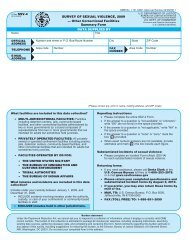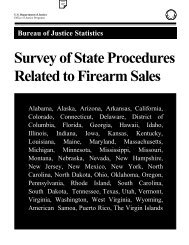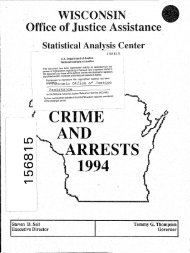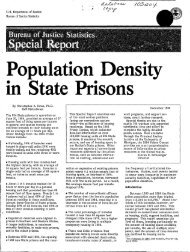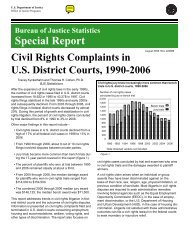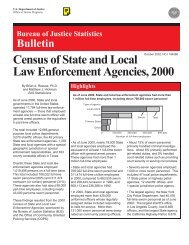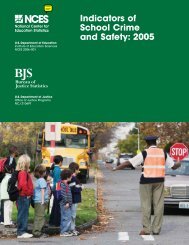Law Enforcement Management and Administration Statistics, 1990 ...
Law Enforcement Management and Administration Statistics, 1990 ...
Law Enforcement Management and Administration Statistics, 1990 ...
Create successful ePaper yourself
Turn your PDF publications into a flip-book with our unique Google optimized e-Paper software.
Introduction<br />
The LEMAS survey<br />
The <strong>1990</strong> <strong>Law</strong> <strong>Enforcement</strong> <strong>Management</strong><br />
<strong>and</strong> Administrative <strong>Statistics</strong> (LEMAS)<br />
survey questionnaire was mailed to ail<br />
780 State <strong>and</strong> local law enforcement<br />
agencies that reported employing 100 or<br />
more sworn officers in tf1e 1986 Directory<br />
Survey of <strong>Law</strong> <strong>Enforcement</strong> Agencies. In<br />
addition, a sample of 2,338 agencies with<br />
fewer than 100 officers received a slightly<br />
abbreviated version of the questionnaire.<br />
The initial mailing of the survey questionnaire<br />
was conducted In July <strong>1990</strong>. The<br />
reference date for personnel-related<br />
questions was the pay period Including<br />
June 15, <strong>1990</strong>. For other questions It was<br />
June 30, <strong>1990</strong>. The data were collected<br />
by the Bureau of the Census for the<br />
Bureau of Justice <strong>Statistics</strong>. Of the 3,118<br />
agencies that received the LEMAS<br />
questionnaire, 2,945 (94.5%) responded,<br />
including 94.6% of those with 100 or more<br />
officers. The <strong>1990</strong> survey was the second<br />
in the triennial LEMAS series. This report<br />
includes only data for agencies with 100<br />
or more officers. For national summary<br />
data on agencies of all sizes, the reader is<br />
referred to the BJS reports State <strong>and</strong><br />
Local Police Departments, <strong>1990</strong><br />
(NCJ-133284); Sheriffs'Departments,<br />
<strong>1990</strong> (NCJ-133283); <strong>and</strong> Drug<br />
<strong>Enforcement</strong> by Police <strong>and</strong> Sheriffs'<br />
Departments, <strong>1990</strong> (NCJ-134505).<br />
Overview of this volume<br />
Agencies included<br />
This volume presents individual agency<br />
data provided by State <strong>and</strong> local law<br />
enforcemer,t agencies in response to the<br />
<strong>1990</strong> LEMAS survey. To be Included, an<br />
agency had to meet the following criteria:<br />
1. Employment of 100 or more full-tima<br />
sworn officers as of March 1986 (reference<br />
month for the 1986 Directory<br />
Survey).<br />
2. Employment of 100 or more full-time<br />
sworn officers as of June <strong>1990</strong> (reference<br />
month for the <strong>1990</strong> LEMASsurvey).<br />
3. Employment of 50 or more full-time<br />
sworn officers working In positions related<br />
to field operations as of June <strong>1990</strong> (to<br />
ensure agency has significant law<br />
enforcement responsibilities).<br />
Secondary State law enforcement<br />
agencies such as those responsible for<br />
the enforcement of alcohol or<br />
conservation laws were not included,<br />
even If they met the above criteria. As<br />
a result, the 49 State agencies included<br />
represent the primary State law enforcement<br />
agency operating In each State<br />
except Hawaii, which has no State law<br />
enforcement agency. A total of 584 local<br />
law enforcement agencies are included-<br />
34 county police departments, 380<br />
municipal police departments, 153<br />
sheriffs' departments, <strong>and</strong> 17 special<br />
police departments.<br />
(The latter category Is comprised of<br />
airport police, transit police, school police,<br />
<strong>and</strong> other agencies with specially-defined<br />
jurisdictions.)<br />
Local law enforcement agencies are<br />
included from all States except North<br />
Dakota, Vermont, <strong>and</strong> Wyoming. These<br />
States had no local law enforcement<br />
agencies that met the above criteria.<br />
A summary of the number <strong>and</strong> type of<br />
agencies from each State is presented<br />
In Table A.<br />
Organization of data tables<br />
The State <strong>and</strong> local law enforcement<br />
agencies with 1,000 or more full-time<br />
sworn personnel working in field operations<br />
are listed in Table B. These are the<br />
agencies that have the largest number of<br />
sworn personnel performing duties directly<br />
related to law enforcement. Summary<br />
data, by type of agency, for most of the<br />
variables that are presented in the individual<br />
agency data tables appear in table<br />
C. The headings In table C correspond to<br />
the eight section headings used for the<br />
individual agency data tables: personnel,<br />
expenditures <strong>and</strong> pay, operations,<br />
vehicles, weapons <strong>and</strong> armor,<br />
computerization, programs <strong>and</strong> policies,<br />
<strong>and</strong> drug enforcement. The reader<br />
should refer to the notes In the<br />
appropriate individual data agency tables<br />
when using data from table C.<br />
Following the 3 summary data tables are<br />
21 tables containing individual data for all<br />
State <strong>and</strong> local law enforcement agencies<br />
with 100 or more officers. Each 01' these<br />
tables is divided into "A" <strong>and</strong> "B" sections.<br />
In the "A" section, data are presented for<br />
the 584 local-level agencies. The "B"<br />
section contains data for the 49 Statelevel<br />
agencies. The tables are in alphabetical<br />
order by State <strong>and</strong> county within<br />
each State. The order of agencies within<br />
each county is not necessarily<br />
alphabetical, because It was determined<br />
by a numerical code on the data tape. At<br />
the end of the "A" <strong>and</strong> "8" section in each<br />
table are explanatory footnotes. This<br />
information should be considered before<br />
using data from each table.<br />
For data items requiring a "yes" or "no"<br />
response, an "X" is used in the tables to<br />
represent a positive response, <strong>and</strong> a<br />
single dash ("_"), a negative one. When<br />
additional categories of responses are<br />
possible (tables 8, 12, <strong>and</strong> 21), code<br />
letters are used. Refer to the explanatory<br />
notes at the end of these tables for<br />
explanation of the codes. For data Items<br />
that required a numerical response, a<br />
single dash is used in Instances where an<br />
item was not applicable to that agency,<br />
<strong>and</strong> a response was not possible. A<br />
single dash Is also used for special police<br />
agencies on all population-related Items,<br />
since the actual resident population<br />
served by these agencies Is not readily<br />
defined. In all tables, a double dash ("--")<br />
Is used in instances where an agency<br />
was unable to provide information.<br />
Statfl <strong>and</strong> Local Agflncifls with 100 or Morfl OffiCflrs<br />
vii




